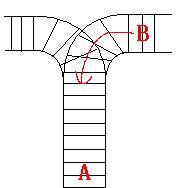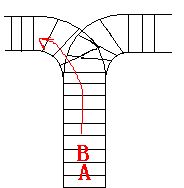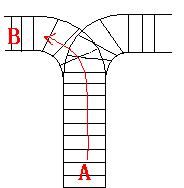hdu1022 Train Problem I 栈的应用
Train Problem I
Time Limit: 2000/1000 MS (Java/Others) Memory Limit: 65536/32768 K (Java/Others)Total Submission(s): 26161 Accepted Submission(s): 9886
Problem Description
As the new term comes, the Ignatius Train Station is very busy nowadays. A lot of student want to get back to school by train(because the trains in the Ignatius Train Station is the fastest all over the world ^v^). But here comes a problem, there is only one railway where all the trains stop. So all the trains come in from one side and get out from the other side. For this problem, if train A gets into the railway first, and then train B gets into the railway before train A leaves, train A can't leave until train B leaves. The pictures below figure out the problem. Now the problem for you is, there are at most 9 trains in the station, all the trains has an ID(numbered from 1 to n), the trains get into the railway in an order O1, your task is to determine whether the trains can get out in an order O2.






Input
The input contains several test cases. Each test case consists of an integer, the number of trains, and two strings, the order of the trains come in:O1, and the order of the trains leave:O2. The input is terminated by the end of file. More details in the Sample Input.
Output
The output contains a string "No." if you can't exchange O2 to O1, or you should output a line contains "Yes.", and then output your way in exchanging the order(you should output "in" for a train getting into the railway, and "out" for a train getting out of the railway). Print a line contains "FINISH" after each test case. More details in the Sample Output.
Sample Input
3 123 321 3 123 312
Sample Output
Yes. in in in out out out FINISH No. FINISHFor the first Sample Input, we let train 1 get in, then train 2 and train 3. So now train 3 is at the top of the railway, so train 3 can leave first, then train 2 and train 1. In the second Sample input, we should let train 3 leave first, so we have to let train 1 get in, then train 2 and train 3. Now we can let train 3 leave. But after that we can't let train 1 leave before train 2, because train 2 is at the top of the railway at the moment. So we output "No.".HintHint
Author
Ignatius.L
Recommend
We have carefully selected several similar problems for you: 1026 1023 1032 1010 1008
Statistic | Submit | Discuss | Note
看到英文题就头痛的啊。。。
于是我就看了输入输出例子 没有读题。。果然wa了。。
只有顶着头皮去看了。。o(︶︿︶)o 唉
给你三个数据 一个是n 表示共有几辆火车,o1是火车的进站顺序,o2是出站顺序,
问按照o1的进站顺序 能不能达到o2的出战顺序。。
用栈模拟火车进出站把、、、
看代码:
#include <stdio.h>
#include <stack>
using namespace std;
int main()
{
char str[15],str1[15],ch;
int a[25],n;//a数组1进站0表示出站
stack<char>s;
while(scanf("%d",&n)!=EOF)
{
scanf("%s",str);
scanf("%s",str1);
while(!s.empty())
s.pop();
s.push('A');//避免第一次访问栈顶访问到不该访问的地方、、
int q=0,t=0,flag=0;
for(int i=0;i<n;i++)
{
ch=str1[i];
if(!flag)
{
while(s.top()!=ch&&q<=n)//如果需要出站的火车不在栈顶,继续进火车
s.push(str[q]),q++,a[t++]=1;
if(s.top()==ch&&!s.empty())//找到了火车出站
a[t++]=0,s.pop();
else//火车进完了还没有找到需要出站的。。
flag=1;
}
if(q==n+1)
flag=1;
}
if(flag)
printf("No.\nFINISH\n");
else
{
printf("Yes.\n");
for(int i=0;i<t;i++)
{
if(a[i]==1)
printf("in\n");
else
printf("out\n");
}
printf("FINISH\n");
}
}
return 0;
}